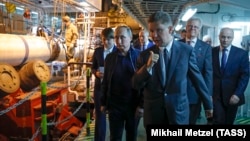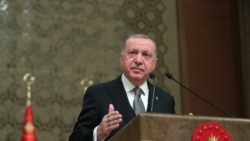When Vladimir Putin visits Istanbul on January 8, the Russian president will be doing more than officially opening a new export pipeline -- he will be getting some more closure on his longstanding dream to end Moscow's dependence on archrival Ukraine in getting natural gas to Europe.
Russia has been seeking to cut gas transit through Ukraine since the mid 2000s, and the $7.8 billion TurkStream pipeline project is a big part of that strategic goal.
The pipeline, which transits the Black Sea and surfaces outside Istanbul, took five years to complete and is one of two major new natural-gas export routes totaling nearly $20 billion that Russia expects to go on line this year.
TurkStream also marks a major achievement for Turkish President Recep Tayyip Erdogan, who has long sought to turn his country into an energy hub and will stand alongside Putin at the January 8 inauguration ceremony.
The pipeline will carry 31.5 billion cubic meters (bcm) of Russian natural gas annually to Turkey’s western province, with half of that volume to be further exported to the Balkans and Central Europe, including Bulgaria, Serbia, and Hungary.
Russia, which exported nearly 200 bcm to Europe in 2019, had been supplying gas to the Balkans and Turkey through an overland route transiting Ukraine, Moldova, and Romania. That gas will now be rerouted through TurkStream, which consists of two lines stretching 930 kilometers each under the Black Sea from just outside the Russian town of Anapa.
South Stream Rejected
Russia twice shut off gas to Ukraine -- in the dead of winter in 2006 and 2009 -- amid price disputes that erupted after pro-Western leaders came to power in Kyiv.
Ukraine had been earning about $3 billion annually in transit fees from Moscow, providing a key source of revenue for the country's struggling economy even as its relations with the Kremlin deteriorated sharply following the 2014 Euromaidan protests and Russia's subsequent seizure of the Crimean Peninsula and support for a separatist conflict in eastern Ukraine.
Russia first sought to build a more ambitious export project to Europe via the Black Sea prior to TurkStream. The South Stream project, proposed in 2007, would have carried 63 bcm a year to Bulgaria via four lines under the sea.
The European Parliament adopted a resolution in 2014 opposing the project on the grounds it violated European Union energy rules. Bulgaria is a member of the EU.
Russia completed Nord Stream 1 under the Baltic Sea to Germany in 2011 to reroute gas around Ukraine and is expected to launch the $11 billion Nord Stream 2 project before the end of the year. The two pipelines have a combined capacity of 110 bcm.
Washington last month imposed sanctions on Nord Stream 2, putting its launch date in doubt.
With the start of TurkStream and Nord Stream 2 on the horizon, the Kremlin last month renegotiated a new gas-transit contract with Kyiv guaranteeing 65 bcm this year and then 40 bcm over the following four years, a drop from nearly 90 bcm in 2019.
TurkStream "directly undermines Ukraine as a gas-transit country and directly undermines Ukrainian security," Margarita Assenova, a senior fellow at the Jamestown Foundation and an energy analyst at the Center for European Policy Analysis in Washington, told RFE/RL.
Alluding to the nearly six-year conflict in the Donbas that has killed nearly 14,000 people since 2014, and which Kyiv and Moscow have recently taken steps to resolve, Assenova said that "Russia would have a freer hand to try to submit Ukraine, to extract a better deal in peace negotiations."
Bulgaria Delay
Russia is likely to ship just a little more than half of the 31.5 bcm through TurkStream in 2020 as Bulgaria has not completed the pipeline that will enable exports to Serbia and beyond, Thierry Bros, an associate at Harvard University’s Davis Center for Russian and Eurasian Studies focusing on energy, told RFE/RL.
Putin last month criticized Bulgaria’s government for falling behind on the project.
The future split of TurkStream’s volumes between Turkey and the Balkans will likely vary depending on developments within the regions, said Nikos Tsafos, an energy analyst at Washington-based Center for Strategic and International Studies.
If Turkey’s economy slumps, more of TurkStream’s gas volumes may go to the Balkans and beyond, Tsafos told RFE/RL.
During Putin's January 8 visit, Erdogan plans to present his counterpart with a specially prepared book on Turkish-Russian relations, which have been hot and cold in recent years.
The two sides have differed over Syria and Libya, both of which will be a major topic of discussion amid heightened tensions in the Middle East and North Africa. But Russia and NATO-member Turkey have also found room for cooperation, and bilateral projects and the delivery of Russian S-400 missile-defense systems will also be on the agenda.
Tsafos said, however, that Turkey will not be able to use its role as a transit state for Russian gas to Europe as leverage over Moscow.
"If Turkey wanted to play politics with this and try to get clever, Russia will switch more gas to Ukraine. Russia having options means no particular route can push too hard," he said
Turkey already imports 16 bcm of Russian gas annually through Blue Stream, another pipeline running under the Black Sea. Blue Stream began operations in 2003.
Azerbaijani Gas, U.S. LNG
Russia is facing increasing competition for the Turkish and Balkan gas markets from competing pipeline projects and liquefied natural gas (LNG).
The U.S.- and EU-backed Trans Adriatic Pipeline will launch later this year carrying Azerbaijani gas across Turkey to Greece, Albania, and Italy. That pipeline has an initial capacity of 10 bcm that can be expanded to more than 20 bcm.
Greece is completing an interconnector pipeline to Bulgaria that would enable Sofia to receive Azerbaijani gas and cut its dependence on Russia.
"Putin was in so much of a hurry to build TurkStream to preempt the Azeris and book capacities," Assenova said.
Bulgaria has been importing nearly all of its gas from Russia. Last year, it received its first shipments of U.S. LNG via a terminal in Greece.
Washington has made LNG exports to Eastern Europe a priority in its foreign policy toward the region.
In September, Energy Secretary Rick Perry inked an agreement to improve infrastructure and secure U.S. natural-gas supplies to Poland and Ukraine, allowing them to lessen their dependence on Russian energy.
The first U.S. LNG cargo destined for Ukraine arrived at a Polish port in November. That same month, U.S. President Donald Trump discussed more LNG exports with Bulgarian Prime Minister Boyko Borissov at the White House.
Washington is also backing plans to export Mediterranean gas to Europe to reduce dependence on Moscow.
Cyprus and Israel have discovered huge natural-gas deposits off their shores in recent years.
Those two countries on January 3 signed an agreement with Greece to construct a 1,900-kilometer undersea pipeline to carry natural gas from Israeli and Cypriot waters to Crete.
The three countries hope to have the pipeline -- which could carry 10 bcm to Europe annually -- completed by 2025.
Analysts have said such a pipeline would be expensive and difficult to complete with many states involved.
Turkey doesn’t recognize Cypriot international waters and is opposed to the project.
European markets could be saturated by then with natural gas as well. LNG would offer Israel and Cyprus greater export flexibility in a rapidly changing energy market environment.
"Why would you put a huge amount of money into a pipeline that will need to operate for 40 years to be profitable if you have no real view of what your gas market is going to be" over that time frame, Bros said of the Mediterranean pipeline.
"You can do easier, cheaper stuff that doesn’t entail having to work with companies and member states," he said.













